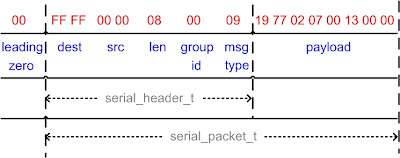A message sent through serial ports from motes to PC will typically look like this:
00 FF FF 00 00 08 00 09 19 77 02 07 00 13 00 00
- The first byte 00 is the leading zero.
- After that, the whole packet is of the type "serial_packet_t", defined in tinyos-2.x/tos/lib/serial/Serial.h.
- Inside the serial_packet_t structure, the first 7 bytes are of the type "serial_header_t", which is also defined in tinyos-2.x/tos/lib/serial/Serial.h.
In the case above, it would be FF FF 00 00 08 00 09.
Within the "serial_header_t", the following structure takes place: - nx_am_addr_t dest // Destination (2 bytes)
- nx_am_addr_t src // Source (2 bytes)
- nx_uint8_t length // Payload Length (1 byte)
- nx_am_group_t group // Group ID (1 byte)
- nx_am_id_t type // Active Message Handler Type (1 byte), some enum value that you can define yourself.
- After the 7 byte header, here comes the payload, which can be up to TOS_DATA_LENGTH (28 bytes) long. The content could be anything.
In the above example, the payload is: 19 77 02 07 00 13 00 00, which is of the length (8 bytes) denoted in the "Payload Length" field.
ref:
http://www.tinyos.net/tinyos-2.x/doc/html/tutorial/lesson4.html. The doc here doesn't seem to be up-to-date since it left out the source address from the header.

